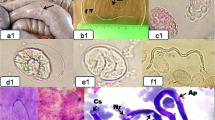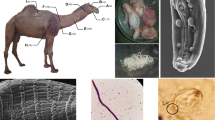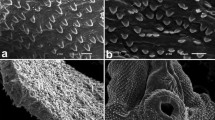Abstract
Filarioid nematodes are parasites of the tissues and tissue spaces of all vertebrates except fish. Females produce microfilariae that enter the host’s blood circulation or skin and may cause ocular and neurological pathology, leading to important implications in veterinary and public health. The present work is the first investigation on Setaria labiatopapillosa conducted in Morocco to characterize the morphological features of both adult and microfilaria forms. Two adult female nematodes were found free in the thoracic cavity of a slaughtered 3.5-year-old (6 teeth) Moroccan enhanced cross-breed bull which was born and raised in Morocco. The worms were identified as S. labiatopapillosa by light microscope (LM) and scanning electron microscopy (SEM) on the basis of their characteristic features of the anterior and posterior parts of the worms. The two S. labiatopapillosa worms measured 90 mm and 105 mm in length and 0.55 and 0.64 mm in width, respectively. Microfilariae were detected in the fully developed eggs contained in the uterus of both nematodes. A detailed morphology of both the adult females and larvae of S. labiatopapillosa is described using LM and SEM. Although the origin of S. labiatopapillosa analyzed in the present study is unknown and there is currently no evidence that Setaria spp. have invaded Morocco, further surveillance is warranted to determine the incidence of setariasis, identify its vectors, and take appropriate measures to protect the livestock and cattle industry of the country.





Similar content being viewed by others
References
Alborzi A, Haddadmolayan P, Tabandeh M, Ghorbanpoor M (2020) Ultrastructural and molecular characteristics of Setaria species based on sequence analysis of genomic and mitochondrial gene markers in cattle (Bos taurus) and buffaloes (Bubalus bubalis) from Iran. J Hellenic Vet Med Soc 70:1777–1788
Azari-Hamidian S, Norouzi B, Harbach RE (2019) A detailed review of the mosquitoes (Diptera: Culicidae) of Iran and their medical and veterinary importance. Acta Trop 194:106–122
Bazargani T, Eslami A, Gholami GR, Molai A, Ghafari-Charati J, Dawoodi J, Ashrafi J (2008) Cerebrospinal nematodiasis of cattle, sheep and goats in Iran. Iran J Parasitol 3:16–20
Becklund WW, Walker ML (1969) Taxonomy, hosts, and geographic distribution of the Setaria (Nematoda: Filarioidea) in the United States and Canada. J Parasitol 55:359–368
Bosch F, Manzanell R, Mathis A (2016) First description of Onchocerca jakutensis (Nematoda: Filarioidea) in red deer (Cervus elaphus) in Switzerland. Int J Parasitol Parasites Wildl 5:192–197
Brengues J, Gidel R (1972) Research on Setaria labiatopapillosa (Perroncito, 1882) in western Africa. II. Dynamics of this filariasis under natural conditions. Ann Parasitol Hum Comp 47:597–611
Chauhan PPS, Pande BP (1980) On the occurrence of Setaria labiatopapillosa in the intestinal lining of buffalo calf. Indian J Parasitol 4:89–91
El Joubari M, Louah A, Himmi O (2014) Mosquitoes (Diptera, Culicidae) of Smir marshes (northwest of Morocco): inventory and biotypology. Bull Soc Pathol Exot 107:48–59
Fujii T, Hayashi T, Ishimoto A, Takahashi S, Asano H, Kato T (1995) Prenatal infection with Setaria marshalli (Boulenger 1921) in cattle. Vet Parasitol 56:303–309
Filali Mouatassem T, Faraj C, Guemmouh R, Rais N, El Ouali LA (2019) Quantitative inventory of mosquito larvae (Diptera: Culicidae) and physicochemical analysis of aquatic habitats in the region of Fez, Morocco. Bull Soc Pathol Exot 112:105–113
Ghahvei Y, Mirzaei M, Hashemnia S, Golchin M, Kheirandish R, Uni S, Mendoza-Roldan JA, Otranto D, Sazmand A (2020) Scanning electron microscopy of Onchocerca fasciata (Filarioidea: Onchocercidae) adults, microfilariae and eggs with notes on histopathological findings in camels. Parasit Vectors 13:249
Gidel R, Brengues J (1972) Research on Setaria labiapapillosa (Perroncito, 1882) in Western Africa. III. Experimental infection of the normal host and of different abnormal hosts. Ann Parasitol 47:613–630
Green PE, Trueman KF (1971) The occurrence of Setaria labiatopapillosa in Queensland. Aust Vet J 47:624
Gueye A, Mbengue M, Diouf A (1989) Ticks and hemoparasitoses of livestock in Senegal. III. The Northern Sudan area. Rev Elev Med Vet Pays Trop 42:411–420
Kaur D, Ganai A, Parveen S, Borkataki S, Yadav A, Katoch R, Godara R (2015) Occurrence of Setaria digitata in a cow. J Parasit Dis 39:477–478
Khedri J, Radfar MH, Borji H, Azizzadeh M (2014) An epidemiological survey of Setaria in the abdominal cavities of Iranian sistani and brahman cattle in the southeastern of Iran. Iran J Parasitol 9:249–253
Kim NS, Kim HC, Sim C, Ji JR, Kim NS, Park BK (2010) Congenital infection with Setaria digitata and Setaria marshalli in the thoracic cavity of a Korean calf: a case report. Vet Med 6:275–280
McFadzean JA (1955) Setarial infections in The Gambia, British West Africa. Ann Trop Med Parasitol 49:417–418
Murugananthan A, Karunanayake EH, Tennekoon KH (2010) Cloning and characterisation of alkali myosin light chain gene (MLC-3) of cattle filarial parasite Setaria digitata. IIOAB J 1:1–10
Nabie R, Spotin A, Rouhani S (2017) Subconjunctival setariasis due to Setaria equina infection; a case report and a literature review. Parasitol Int 66:930–932
Nakano H, Tozuka M, Ikadai H, Ishida H, Goto R, Kudo N, Katayama Y, Muranaka M, Anzai T, Oyamada T (2007) Morphological survey of bovine Setaria in the abdominal cavities of cattle in Aomori and Kumamoto prefectures, Japan. J Vet Med Sci 69:413–415
Ndao M, Pandey VS, Zinsstag J, Pfister K (1995) Helminth parasites and hypobiosis of nematodes in N’Dama cattle during the dry season in The Gambia. Vet Parasitol 60:161–166
Nelson GS (1962) Observations on the development of Setaria labiatopapillosa using new techniques for infecting Aedes aegypti with this nematode. J Helminthol 36:281–296
Ogbogu VC, Bablis JM, Ajanusi OJ (1990) Prevalence of microfilariae in cattle at slaughter in Zaria, Nigeria. Vet Parasitol 36:171–175
Osipov AN (1972) Observations on the microfilarial numbers and on the life span of Setaria labiatopapillosa in cattle. Bylleten vsesoyuzwogo Gelmintologii im ki Stryabina 9:52–54
Panaitescu D, Preda A, Bain O, Vasile-Bugarin A. C (1999) Four cases of human filariosis due to Setaria labiatopapillosa found in Bucharest, Romania. Roum Arch Microbiol Immunol 58:203–207
Pelligrini N, Ramboli B, Poli A, Renzoni G, Gioli G (1980) Eosinophilic granuloma caused by adult Setaria labiatopapillosa in the bovine diaphragm. Anatamo-histopathological findings and pathogenic considerations. Annali Facolta di Medicina Veterinari di pisa 33:103–112
Perumal ANI, Gunawardene YINS, Dassanayake RS (2016) Setaria digitata in advancing our knowledge of human lymphatic filariasis. J Helminthol 90:129–138
Rao KSP (1941) Worm in the anterior chamber of the eye of a bullock. Indian Vet J 18:35
Rhee JK, Choi EY, Park BK, Jang BG (1994) Application of scanning electron microscopy in assessing the prevalence of some Setaria species in Korean cattle. Korean J Parasitol 32:1–6
Sarwar MM (1945) On the pathogenicity of Setaria cervi (Rud. 1819) in buffaloes. Curr Sci 14:107
Sarwar MM (1946) Two species of the nematode genus Setaria Vibrog. Indian Vet J 22:405–409
Schuster RK, Wibbelt G, Maio E, Wernery U, Sivakumar S (2019) Diaplacental infection of a bactrian camel (Camelus bactrianus) with the filarial worm Dipetalonema evansi: a case report. J Camel Pract Res 26:231–235
Shin J, Ahn KS, Suh GH, Kim HJ, Jeong HS, Kim BS, Choi E, Shin SS (2017) First blindness cases of horses infected with Setaria digitata (Nematoda: Filarioidea) in the Republic of Korea. Korean J Parasitol 55:667–671
Shin SS, Cho KO, Wee SH (2002) Ocular infection of cattle with Setaria digitata. J Vet Med Sci 64:7–10
Shoho C (1958) Studies on cerebrospinal nematodiasis in Ceylon. Ceylon Vet J 6:10–15
Shoho C (1976a) Setaria species from water buffalo of Southeast Asia and from Caffer Buffalo of Africa: comparative study with Setaria spp. from cattle of the respective areas. Ann Parasitol Hum Comp 51:577–588
Shoho C (1976b) On Setaria spp. (Nematoda, Filarioidea, Setariidae) from the peritoneal cavity of equine spp.: two new sub-species, Setaria equina theilerae from wild zebra of Africa, and Setaria equina dafaallai from horses and donkeys of southern Sahara area. Ann Parasitol Hum Comp 51:589–599
Shoho C, Nair VK (1960) Studies of cerebrospinal nematodiasis in Ceylon. VII. Experimental production of cerebrospinal nematodiasis by the inoculation of infective larvae of Setaria digitata into susceptible goats. Ceylon Vet J 8:1–11
Shoho C, Uni S (1977) Scanning electron microscopy (SEM) of some Setaria species (Filarioidea, Nematoda). Zeitschrift für Parasitenkunde 53:93–104
Sigraskar SU, Chouduri PC, Singhari NA (1999) Bubaline microfilariasis: epizootiological studies. Buffalo Bull 18:64–66
Singh ST, Malhotra P, Singla LD (2014) Fatal natural infection with microfilariae of Setaria species in a cattle bull. Prog Res 9:355–356
Singla LD, Moudgil AD, Sood NK, Deshmukh S, Turkar S, Uppal SK (2014) A unique case report on Setaria species microfilariosis in adult cattle in Punjab (India). Int Sci J 1:1–3
Sundar ST, D’Souza PE (2015) Morphological characterization of Setaria worms collected from cattle. J Parasit Dis 39:572–576
Ţălu S, Ştefănuţ A, Mihalca A, Coroiu Z (2012) Subconjunctival infestation with Setaria. Helminthologia 49:119–121
Trari B, Dakki M, Himmi O, El Agbani MA (2003) Mosquitoes (Diptera: Culicidae) of Morocco. Bibliographic review (1916–2001) and inventory of the species. Bull Soc Pathol Exot 96:329–334
Tung KC, Lai CH, Ooi HK, Yang CH, Wang JS (2003) Cerebrospinal setariosis with Setaria marshalli and Setaria digitata infection in cattle. J Vet Med Sci 65:977–983
Acknowledgments
The authors thank the farmers and breeders in Kénitra region (Morocco), the director of municipal slaughterhouse in Kénitra for collection of parasites, and Unité d’appui technique à la recherche scientifique of Centre National pour la Recherche Scientifique et Technique (CNRST, Rabat, Morocco) for technical support and use of scanning electronic microscope.
Author information
Authors and Affiliations
Contributions
This work is part of PhD thesis of RM under the guidance of his thesis director KEK. RM, KEK, and DB conceived and designed the experiments. RM performed the experiments. RM, MAL, KEK, and DB analyzed the data. RM, DB, and LB wrote the manuscript. All authors read and approved the final manuscript.
Corresponding author
Ethics declarations
Conflict of interest
The authors declare that they have no conflict of interest.
Additional information
Section Editor: Abdul Jabbar
Publisher’s note
Springer Nature remains neutral with regard to jurisdictional claims in published maps and institutional affiliations.
Rights and permissions
About this article
Cite this article
Mrifag, R., Lemrabott, M.A., El Kharrim, K. et al. Setaria labiatopapillosa (Filarioidea, Nematoda) in Moroccan cattle: atypical localization and morphological characterization of females and microfilariae by light and scanning electron microscopy. Parasitol Res 120, 911–918 (2021). https://doi.org/10.1007/s00436-020-06966-z
Received:
Accepted:
Published:
Issue Date:
DOI: https://doi.org/10.1007/s00436-020-06966-z




